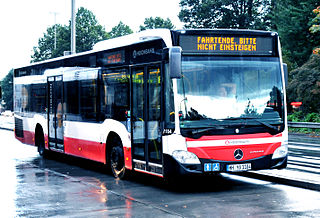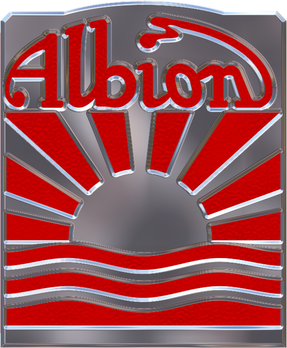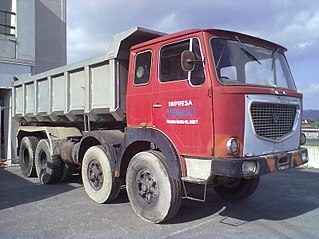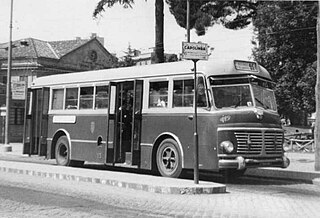
The Toyota G1 was the first truck built by the company that became Toyota. It was 6 m (20 ft) long, could carry 1.5 tons, and was loosely based on similar class Ford and GM trucks.

Dodge has used the B series name on two different vehicles, a pickup truck and a van.

Mercedes-Benz has been producing buses since 1895 in Mannheim in Germany. Since 1995 Mercedes-Benz buses and coaches is a brand of EvoBus GmbH, a wholly owned subsidiary of Daimler Truck.

Seddon Atkinson Vehicles Limited, was a manufacturer of large goods vehicles based in Oldham, Greater Manchester, England, was formed after the acquisition in 1970 of Atkinson Vehicles Limited of Preston by Seddon Diesel Vehicles Limited of Oldham. In 1974, the firm was acquired by International Harvester, which sold it in March 1984 to the Spanish group Enasa which made it a subsidiary of Pegaso. In 1990, it became part of Iveco which used the brand for various types of specialised vehicles in the United Kingdom. The range of models produced included EuroMover, Pacer and Strato, which are aimed at refuse collection, recycling and construction operators.

Albion Motors was a Scottish automobile and commercial vehicle manufacturer.

Guy Motors was a Wolverhampton-based vehicle manufacturer that produced cars, lorries, buses and trolleybuses. The company was founded by Sydney S. Guy (1885–1971) who was born in Kings Heath, Birmingham. Guy Motors operated out of its Fallings Park factory from 1914 to 1982, playing an important role in the development of the British motor industry.

The Leyland Leopard was a mid-engined single-decker bus and single-decker coach chassis manufactured by Leyland between 1959 and 1982.

The Lancia Appia is a passenger car introduced in 1953 by Italian car manufacturer Lancia as a replacement for the Ardea, and which remained in production for ten years. The Appia was the last in a long line of Lancia production cars dating back to the Lancia Lambda to use sliding pillar front suspension. All three series produced had a 1089cc Lancia V4 engine.

The Lancia Artena is a passenger car produced by Italian car manufacturer Lancia from 1931 until 1936, and from 1940 until 1942 chiefly for army and government use. It was powered by a 2-litre Lancia V4 engine, while chassis and factory bodies were shared with the more luxurious 2.6-litre V8-engined Lancia Astura. Total production amounted to 5,567 examples.

The M39 series 5-ton 6×6 truck (G744) was a family of heavy tactical trucks built for the United States Armed Forces. The basic cargo version was designed to transport a 5-ton (4,500 kg), 14 ft (4.3 m) long load over all terrain in all weather. In on-road service the load weight was doubled.

Straker-Squire was a British automobile manufacturer based in Bristol, and later Edmonton in North London.

Canadian Military Pattern (CMP) trucks were mutually coherent ranges of military trucks, made in large numbers, in several classes and numerous versions, by Canada's branches of the U.S. 'Big Three' auto-makers during World War II, compliant to British Army specifications, primarily intended for use in the armies of the British Commonwealth allies, but also serving in other units of the British Empire.

The GMC CCKW, also known as "Jimmy", or the G-508 by its Ordnance Supply Catalog nr, was a highly successful series of off-road capable, 21⁄2-ton, 6×6 trucks, built in large numbers to a standardized design for the U.S. Army, that saw heavy service, predominantly as cargo trucks, in both World War II and the Korean War. The original "Deuce and a Half", it formed the backbone of the famed Red Ball Express that kept Allied armies supplied as they pushed eastward after the Normandy invasion.
The Lancia Ro, Lancia Ro-Ro and Lancia 3Ro were 4x2 heavy trucks built by Italian manufacturer Lancia from the 1930s through the 1940s for military and civilian use. The 2-cylinder diesel Ro was produced from 1933 to 1939, the 3-cylinder diesel Ro-Ro from 1935 to 1939 and the improved 5-cylinder diesel 3Ro from 1938 to 1947.

The Chevrolet Van or Chevy Van is a range of vans that was manufactured by General Motors from the 1964 to 1996 model years. Introduced as the successor for the rear-engine Corvair Corvan/Greenbrier, the model line also replaced the panel van configuration of the Chevrolet Suburban. The vehicle was sold both in passenger van and cargo van configurations as well as a cutaway van chassis that served as the basis for a variety of custom applications.

Lancia Esagamma is a truck and bus chassis produced by Italian car manufacturer Lancia from 1962 to 1973.

Lancia Esatau is a series of truck and bus chassis produced by Italian manufacturer Lancia Industrial Vehicles from 1947 to 1973. 13,362 examples were produced.

The Lancia Jota is a series of truck and bus chassis produced by Lancia between 1915 and 1935. The original 1915 Jota was the first true Lancia truck; throughout the following two decades it was made in a number of different series and variants, each identified by a progressive Greek numeral prefix added to the name, from Djota to the last Eptajota. While axle tracks, wheelbase and equipment gradually grew, the original layout and 4,940 cc four-cylinder petrol engine were retained.

The Mack model EH trucks were a family of 4x2 trucks used by the US and British military before and during World War II. They were built in conventional and cab-over-engine models and were used as both trucks and semi-tractors. Originally a commercial design, in 1943 a military version became standard.

The 6-ton 6×6 truck was a family of heavy tactical trucks built for the United States Army during World War II. The basic cargo version was designed to transport a 6- short ton (5,400 kg) cargo load over all terrain in all weather. The chassis were built by Brockway Motor Company, The Corbitt Company, The Four Wheel Drive Auto Company (FWD), Ward LaFrance Truck Corporation, and White Motor Company. They were replaced by the M54 5-ton 6x6 trucks in the 1950s.



















